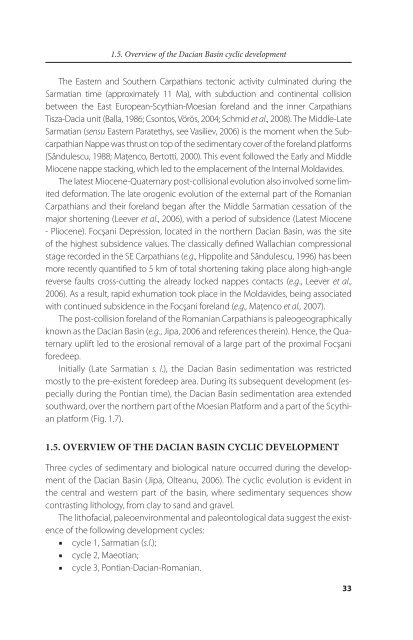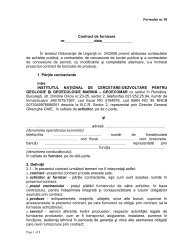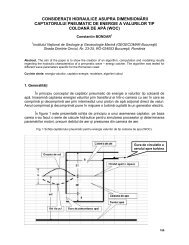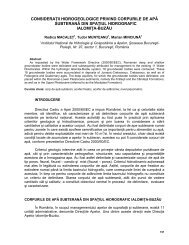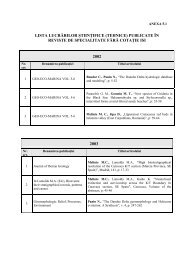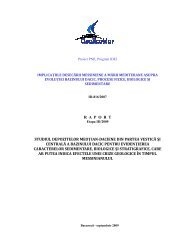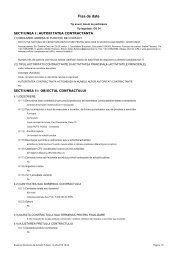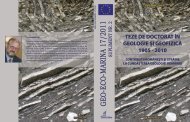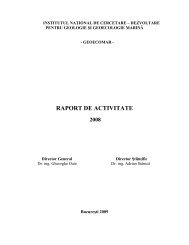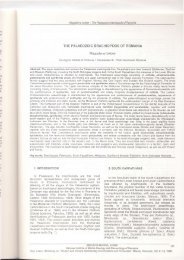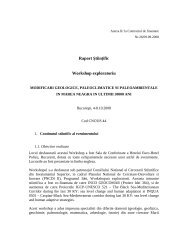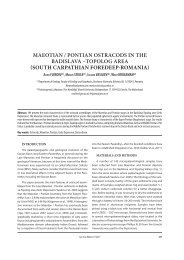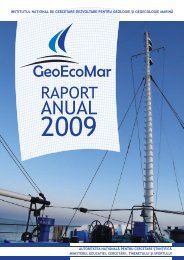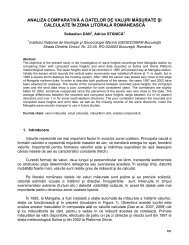DACIAN BASIN - GeoEcoMar
DACIAN BASIN - GeoEcoMar
DACIAN BASIN - GeoEcoMar
You also want an ePaper? Increase the reach of your titles
YUMPU automatically turns print PDFs into web optimized ePapers that Google loves.
1.5. Overview of the Dacian Basin cyclic development<br />
The Eastern and Southern Carpathians tectonic activity culminated during the<br />
Sarmatian time (approximately 11 Ma), with subduction and continental collision<br />
between the East European-Scythian-Moesian foreland and the inner Carpathians<br />
Tisza-Dacia unit (Balla, 1986; Csontos, Vörös, 2004; Schmid et al., 2008). The Middle-Late<br />
Sarmatian (sensu Eastern Paratethys, see Vasiliev, 2006) is the moment when the Subcarpathian<br />
Nappe was thrust on top of the sedimentary cover of the foreland platforms<br />
(Săndulescu, 1988; Maţenco, Bertotti, 2000). This event followed the Early and Middle<br />
Miocene nappe stacking, which led to the emplacement of the Internal Moldavides.<br />
The latest Miocene-Quaternary post-collisional evolution also involved some limited<br />
deformation. The late orogenic evolution of the external part of the Romanian<br />
Carpathians and their foreland began after the Middle Sarmatian cessation of the<br />
major shortening (Leever et al., 2006), with a period of subsidence (Latest Miocene<br />
- Pliocene). Focşani Depression, located in the northern Dacian Basin, was the site<br />
of the highest subsidence values. The classically defined Wallachian compressional<br />
stage recorded in the SE Carpathians (e.g., Hippolite and Săndulescu, 1996) has been<br />
more recently quantified to 5 km of total shortening taking place along high-angle<br />
reverse faults cross-cutting the already locked nappes contacts (e.g., Leever et al.,<br />
2006). As a result, rapid exhumation took place in the Moldavides, being associated<br />
with continued subsidence in the Focşani foreland (e.g., Maţenco et al., 2007).<br />
The post-collision foreland of the Romanian Carpathians is paleogeographically<br />
known as the Dacian Basin (e.g., Jipa, 2006 and references therein). Hence, the Quaternary<br />
uplift led to the erosional removal of a large part of the proximal Focşani<br />
foredeep.<br />
Initially (Late Sarmatian s. l.), the Dacian Basin sedimentation was restricted<br />
mostly to the pre-existent foredeep area. During its subsequent development (especially<br />
during the Pontian time), the Dacian Basin sedimentation area extended<br />
southward, over the northern part of the Moesian Platform and a part of the Scythian<br />
platform (Fig. 1.7).<br />
1.5. OvERvIEw OF THE <strong>DACIAN</strong> <strong>BASIN</strong> CYCLIC DEvELOPMENT<br />
Three cycles of sedimentary and biological nature occurred during the development<br />
of the Dacian Basin (Jipa, Olteanu, 2006). The cyclic evolution is evident in<br />
the central and western part of the basin, where sedimentary sequences show<br />
contrasting lithology, from clay to sand and gravel.<br />
The lithofacial, paleoenvironmental and paleontological data suggest the existence<br />
of the following development cycles:<br />
■ cycle 1, Sarmatian ( s.l.);<br />
■ cycle 2, Maeotian;<br />
■<br />
cycle 3, Pontian-Dacian-Romanian.<br />
33


